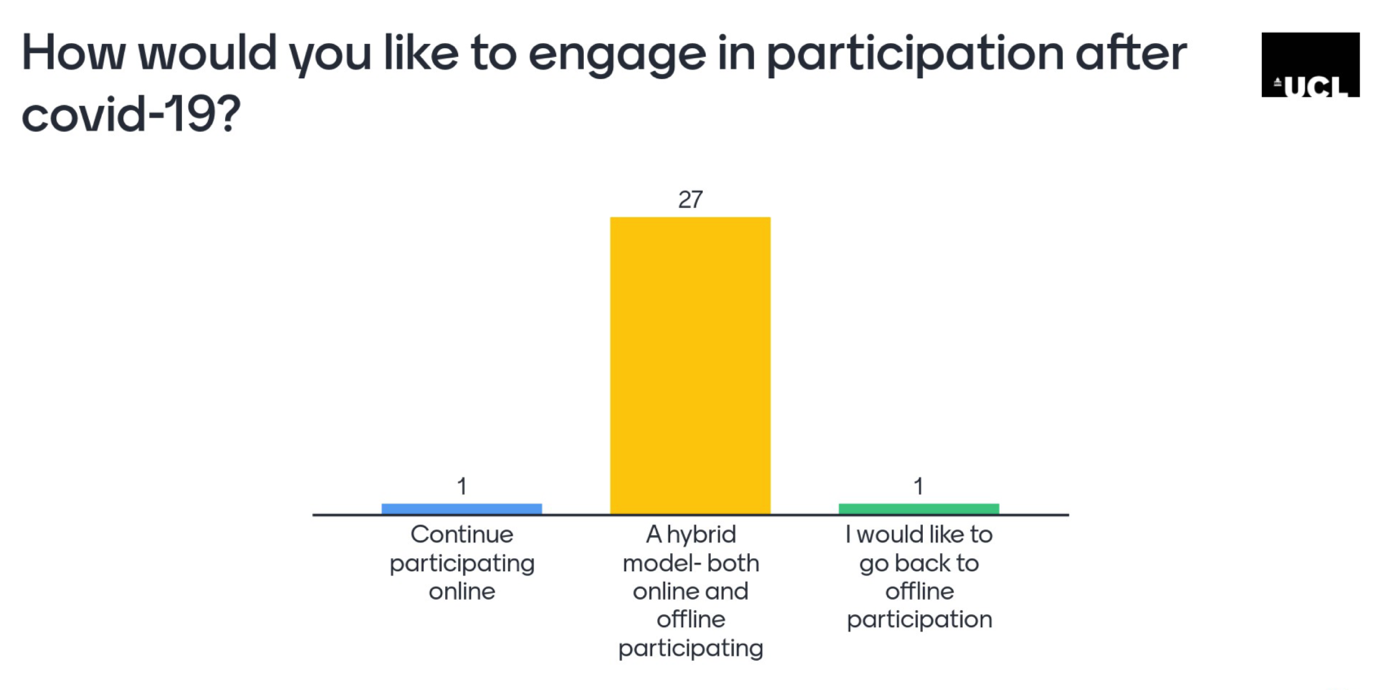Written by:
As a group of planning students from UCL, we worked alongside The Glass-House in our module, Participatory Urban Planning, to consider how COVID-19 has changed public participation in planning. This blog post summarises our findings that can be accessed in full by reading the entire report here.
We wrote this report in the context of social distancing restrictions imposed by the UK government to prevent the spread of the COVID-19 Pandemic. This led to public participation in planning to transition to the use of more digital methods. Since the first lockdown, forced reliance on digital participation has revealed that the method brings a unique set of challenges and benefits for both participants and organisers.
In light of this, we aimed to explore how the pandemic and the subsequent transition from less face-to-face to more online participation has affected public participation in planning. Through a series of interviews with practitioners and community members, webinars and academic research such as the study conducted by the RTPI, we considered how they view digital participation to conduct community engagement in planning. Taking this knowledge forward, we provided our suggestions for best practice in what we term the ‘hybrid approach’ that harnesses the advantages that both aspects of participation can bring in decision and plan making.
To achieve this, we set out three research questions:
- How have practitioners adapted to COVID-19 constraints and what have been the benefits?
- What have been the main challenges in terms of online participation during COVID-19?
- Considering experience of digital participation, what are participants expectations going forward?
We found that the shift to fully online based participation and consultation during the height of the pandemic demonstrated the adaptability of many planning organisations to continue to engage with the public, even when the traditional, face-to-face engagement was not an option. Practitioners also demonstrated a degree of creativity in what can be achieved online. Nevertheless, the challenges of online participation should not be overlooked, particularly around who the technology includes and excludes. In some scenarios our interviewees found the benefits outweighed the costs of online participation, so moving forward to when face-to-face events are once again permitted, many organisations expect to continue some form of online interaction with communities. However, the importance of considering who you wish to engage is paramount in terms of ensuring the online aspect of participation does not hinder data collection.
As we are only at the beginning of the move to more widespread online participation, it is likely new tools and methods will be introduced. This will hopefully further improve online participation processes as well as overcome some of the initial challenges as it becomes more commonplace. It seems there is a trend emerging from the organisations we have spoken to in that a hybrid approach for participation methods, inclusive of online and face to face interactions, seems the most appropriate model moving forward.

With the data collected and taking different points of view and constraints into consideration, we set six general recommendations for future practice:
- Adopt a hybrid approach to maximise the newly discovered benefits of digital participation whilst neutralising the issues of digital divides and incorporating well-established physical participation methods.
- Plan early and comprehensively when organising hybrid participation events to ensure both parties get the most out of them.
- Undertake further research into the use of digital participation to monitor the continued use of digital participation post-pandemic, with key focuses on the mitigation of accessibility issues through a hybrid approach.
- Embrace the opportunities that digital planning presents for innovation to tailor each approach to engagement and implement creative technologies.
- Employ a facilitator when holding online participation events to engage all participants and use any participation tools on behalf of participants.
- Be creative with the digital tools available to prevent digital exclusion, by considering the needs of the audience over what you require from them.

The changing nature of COVID-19 means there is some degree of speculation as to what the future will look like in relation to online participation in planning. Online participation will likely continue to change the way communities and planning practitioners interact, but by highlighting the challenges and benefits early on we hope our report may serve as a useful source for those engaging in the process.
As a group of seven planning students from UCL, we worked alongside The Glass-House in our module, Participatory Urban Planning, to consider how COVID-19 has changed public participation in planning. We are at the start of our careers in planning and have found this project useful in reflecting on changes that the pandemic has brought about and will likely alter how we view participation in the future.
We’d like to thank the UCL students for sharing their initial findings, which we wrote about here and their research report with us.
